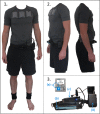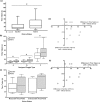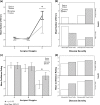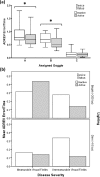A novel, wearable, electronic visual aid to assist those with reduced peripheral vision
- PMID: 31613911
- PMCID: PMC6793879
- DOI: 10.1371/journal.pone.0223755
A novel, wearable, electronic visual aid to assist those with reduced peripheral vision
Abstract
Purpose: To determine whether visual-tactile sensory substitution utilizing the Low-vision Enhancement Optoelectronic (LEO) Belt prototype is suitable as a new visual aid for those with reduced peripheral vision by assessing mobility performance and user opinions.
Methods: Sighted subjects (n = 20) and subjects with retinitis pigmentosa (RP) (n = 6) were recruited. The LEO Belt was evaluated on two cohorts: normally sighted subjects wearing goggles to artificially reduce peripheral vision to simulate stages of RP progression, and subjects with advanced visual field limitation from RP. Mobility speed and accuracy was assessed using simple mazes, with and without the LEO Belt, to determine its usefulness across disease severities and lighting conditions.
Results: Sighted subjects wearing most narrowed field goggles simulating most advanced RP had increased mobility accuracy (44% mean reduction in errors, p = 0.014) and self-reported confidence (77% mean increase, p = 0.004) when using the LEO Belt. Additionally, use of LEO doubled mobility accuracy for RP subjects with remaining visual fields between 10° and 20°. Further, in dim lighting, confidence scores for this group also doubled. By patient reported outcomes, subjects largely deemed the device comfortable (100%), easy to use (92.3%) and thought it had potential future benefit as a visual aid (96.2%). However, regardless of severity of vision loss or simulated vision loss, all subjects were slower to complete the mazes using the device.
Conclusions: The LEO Belt improves mobility accuracy and therefore confidence in those with severely restricted peripheral vision. The LEO Belt's positive user feedback suggests it has potential to become the next generation of visual aid for visually impaired individuals. Given the novelty of this approach, we expect navigation speeds may improve with experience.
Conflict of interest statement
The authors have declared that no competing interests exist.
Figures








References
-
- Russell S, Bennett J, Wellman JA, Chung DC, Yu Z-F, Tillman A, et al. Efficacy and safety of voretigene neparvovec (AAV2-hRPE65v2) in patients with RPE65-mediated inherited retinal dystrophy: a randomised, controlled, open-label, phase 3 trial. The Lancet. 2017;390(10097):849–60. 10.1016/S0140-6736(17)31868-8. - DOI - PMC - PubMed
-
- U.S. Food and Drug Administration (FDA). FDA approves novel gene therapy to treat patients with a rare form of inherited vision loss [WebContent]. 2017 [28th August 2018]. Available from: https://www.fda.gov/newsevents/newsroom/pressannouncements/ucm589467.htm.
-
- Kim Y, Harders M, Gassert R. Identification of Vibrotactile Patterns Encoding Obstacle Distance Information. IEEE Transactions on Haptics. 2015;8(3). - PubMed
Publication types
MeSH terms
Grants and funding
LinkOut - more resources
Full Text Sources

